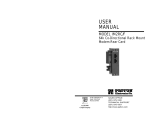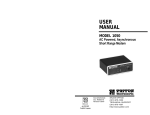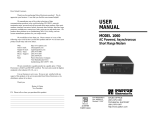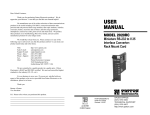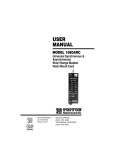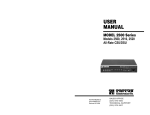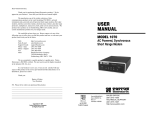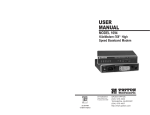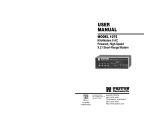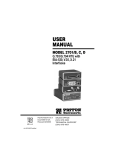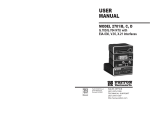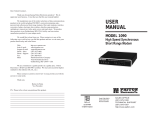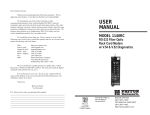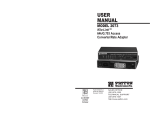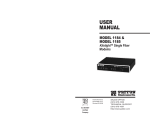Download Patton electronic 2450 User's Manual
Transcript
USER MANUAL MODEL 2450 56/64 Kbps, 4-Wire DDS & Clear Channel CSU/DSU Part# 07M2450-B Doc# 099051UB Revised 3/12/97 CERTIFIED An ISO-9001 Certified Company SALES OFFICE (301) 975-1000 TECHNICAL SUPPORT (301) 975-1007 http://www.patton.com 1.0 WARRANTY INFORMATION Patton Electronics warrants all Model 2450 components to be free from defects, and will—at our option—repair or replace the product should it fail within one year from the first date of shipment. This warranty is limited to defects in workmanship or materials, and does not cover customer damage, abuse or unauthorized modification. If this product fails or does not perform as warranted, your sole recourse shall be repair or replacement as described above. Under no condition shall Patton Electronics be liable for any damages incurred by the use of this product. These damages include, but are not limited to, the following: lost profits, lost savings and incidental or consequential damages arising from the use of or inability to use this product. Patton Electronics specifically disclaims all other warranties, expressed or implied, and the installation or use of this product shall be deemed an acceptance of these terms by the user. 1.1 RADIO AND TV INTERFERENCE The Model 2450 generates and uses radio frequency energy, and if not installed and used properly—that is, in strict accordance with the manufacturer's instructions—may cause interference to radio and television reception. The Model 2450 has been tested and found to comply with the limits for a Class A computing device in accordance with the specifications in Subpart J of Part 15 of FCC rules, which are designed to provide reasonable protection from such interference in a commercial installation. However, there is no guarantee that interference will not occur in a particular installation. If the Model 2450 does cause interference to radio or television reception, which can be determined by disconnecting the RS-232 interface, the user is encouraged to try to correct the interference by one or more of the following measures: moving the computing equipment away from the receiver, re-orienting the receiving antenna and/or plugging the receiving equipment into a different AC outlet (such that the computing equipment and receiver are on different branches). In the event the user detects intermittent or continuous product malfunction due to nearby high power transmitting radio frequency equipment, the user is strongly advised to use data cables with an exterior outer shield bonded to a metal or metalized connector 1.2 FCC INFORMATION Your telephone company may make changes in its facilities, equipment, operations or procedures that could affect the proper operation of the Model 2450 Series. If this happens, the telephone company should give you advance notice to prevent the interruption of your service. The telephone company may decide to temporarily discontinue your service if they believe your Model 2450 Series may cause harm to the telephone network. Whenever possible, they will contact you in advance. If you elect to do so, you have the right to file a complaint with the FCC. The telephone company may ask you to disconnect the equipment from the telephone network until the problem has been corrected or until you are certain that the Model 2400 Series is not malfunctioning. The following information may be required when applying to your local telephone company for leased line facilities. Service Type 56 Kbps 64 Kbps Digital Facility Interface Code 04 DU5 - 56 04 DU5 - 64 Service Order Code 6.0F 6.0F 1.3 SERVICE INFORMATION All warranty and non-warranty repairs must be returned freight prepaid and insured to Patton Electronics. All returns must have a Return Materials Authorization number on the outside of the shipping container. This number may be obtained from Patton Electronics Technical Support: (301) 975-1007; http://www.patton.com; or, [email protected]. Notice: Packages received without an RMA number will not be accepted. Patton Electronics' technical staff is also available to answer any questions that might arise concerning the installation or use of your Model 2400. Technical Service hours: 8AM to 5PM EST, Monday through Friday. 1.4 CE NOTICE The CE symbol on your Patton Electronics equipment indicates that it is in compliance with the Electromagnetic Compatibility (EMC) directive and the Low Voltage Directive (LVD) of the Union European (EU). A Certificate of Compliance is available by contacting Patton Technical Support. The Model 2400 Series has been tested and registered in compliance with the specifications in Part 68 of the FCC rules. A label on the equipment bears the FCC registration number. You may be requested to provide this information to your telephone company. 1 Network Jacks RJ48S RJ48S 2 3.0 CONFIGURATION 2.0 GENERAL INFORMATION Thank you for your purchase of this Patton Electronics product. This product has been thoroughly inspected by Patton's qualified technicians. If any questions or problems arise during installation or use of this product, please do not hesitate to contact Patton Electronics Technical Support at (301) 975-1007. 2.1 FEATURES • • • • • • • • • • • • • Synchronous data rates of 56 or 64 Kbps Full duplex communication over two dedicated twisted pairs Supports distances to 3.4 miles over 26 AWG wire Selectable internal, external or network rcv/recover clock options Built-in V.54 loopback tests and V.52 BER test patterns Works with 56 Kbps DDS, 64 Kbps Clear Channel, or private twisted pair circuits Switchable Circuit Assurance feature Externally accessible configuration switches Six front panel LEDs monitor communication and test status RJ-48S jack provided for line connection RS-232 & RS-422/530 versions have DB-25 connector V.35 version has either DB-25 or M/34 connector Ultra-compact enclosure fits in tight spaces The Model 2450 is easy to install and is ruggedly designed for excellent reliability: just set it and forget it. The following instructions will help you set up and install the Model 2450 properly. 3.1 CONFIGURATION SWITCHES The Model 2450 uses a mini DIP switch package that allows configuration to a wide range of applications. This DIP switch is externally accessible from the underside of the Model 2450 (see Figure 1, below), therefore you do not need to open the Model 2450's case during configuration. REAR ON 1 2 3 4 5 6 7 8 S1 FRONT Figure 1. Underside of Model 2450, showing location of DIP switches 2.2 DESCRIPTION 3.2 CONFIGURATION SWITCH SET “S1” The Model 2450 DDS & Clear Channel CSU/DSU is a standalone , AC powered CSU/DSU designed for 4-wire, full duplex communications over dedicated twisted-pair. Synchronous data rates of 56 and 64 Kbps are supported, at distances up to 3.4 miles. The Model 2450 provides selectable timing options of internal, external or network receiverecovered clock. A circuit assurance feature is also provided. For user convenience, the Model 2450’s DIP switches are externally accessible, so there is no need to open the case to configure the unit. The Model 2450’s built-in V.54 loopback test modes and V.52 BER test patterns are accessed using two front panel switches. Six front panel LEDs monitor test modes and communication status. Line connections are facilitated by a modular RJ-48S jack on the rear of the unit. The switches shown in Figure 2 below and on DIP switch S1 control clock mode, circuit assurance, RTS, data rate and test loop functions. Following Figure 2 are factory default settings and detailed switch descriptions for each switch. 3 4 ON ON 1 2 3 4 5 6 7 8 OFF Figure 2. Close-up of DIP switches showing “ON” and “OFF” positions Switch S1-3: Circuit Assurance S1 SUMMARY TABLE Position Function Factory Default S1-1 Clock Mode Off S1-2 Clock Mode On S1-3 Circuit Assurance Off Disabled S1-4 RTS On Forced On S1-5 Line Rate Off 56 kbps S1-6 Front Panel Switches Off Enabled S1-7 DTE Loop Control On Disabled S1-8 Receive RDL Off Enabled } Network On dedicated circuits, the transmitter and the CTS output can be configured to go On only when a working communication circuit is established. If Circuit Assurance is used, enable it on only one end of the communication link. S1-3 On Circuit Assurance Enabled Off Disabled Switches S1-1 and S1-2: Clock Mode The setting for switches S1-1 and S1-2 determines the transmitter clocking mode for the Model 2450. S1-1 S1-2 Clock Mode Description On Off External (DTE) Transmit clock derived from terminal interface Off On Network (Looped) Transmit clock derived from the received line signal; Use this mode for Dedicated DDS operation Off Off Internal (Master) Transmit clock derived internally On On Campus Clock Transmit clock derived from received line signal. Allows remote device (in campus clock mode) to initiate V.54 loopback. For use only in campus shorthaul configuration. (Note: Local device must be in internal clock mode.) 5 Description CTS will go low and the transmitter will be held off if the receiver is in the No Signal state or CD is low The transmitter and CTS will operate without regard to the receiver state Switch S1-4: RTS The RTS input can be forced on, ignoring the terminal’s RTS signal. RTS controls the transmitter by either sending the user’s data or sending an idle code. S1-4 On RTS Forced On Description Transmitter is always ON Off Follows DTE Signal The RTS input controls the transmitter Switches S1-5: Data Rate This switch controls the data rate on the line (RJ-48S port) and must match the speed of your digital service. S1-5 Off Setting 56 kbps On 64 kbps 6 4.0 INSTALLATION Switch S1-6: Front Panel Switch Enable/Disable Switch S1-6 determines whether the front panel switches may be used to perform diagnostic functions. S1-6 Off On Activation Enabled Disabled Description Front panel switches may be used to activate/terminate diagnostics Front panel switches will have no effect on operation of the unit Switch S1-7: DTE Loop Request Line Enable/Disable The setting for switch S1-7 determines whether the DTE signals can be used to activate/terminate the loopback diagnostic modes and BER test patterns. S1-7 Off DTE TM Line Activation Enabled On Disabled The Model 2450 is designed for 4-wire, full duplex communication over a DDS or Clear Channel carrier circuit, or over dedicated twisted pair. This section will describe proper connection of the line interface, the DTE (terminal) interface, and the AC power supply. 4.1 LINE (NETWORK) CONNECTION The RJ-48S port on a Model 2450 CSU/DSU is prewired for a standard TELCO wiring environment (see Figure 4, below). Connect this port to the RJ-48S jack provided by your digital service carrier using a straight through twisted pair cable between 19 and 26 AWG. To be sure you have the right wiring, use the table below as a guide. 1 2 3 4 5 6 7 8 Description DTE Loop request line switches may be used to activate/terminate diagnostics. DTE loop request lines will have no effect on operation of the unit. 1 (TX+) 2 (TX-) 3 (N/C) 4 (N/C) 5 (N/C) 6 (N/C) 7 (RX+) 8 (RX-) Figure 4. Interface pinouts for Model 2450 RJ-48S jack. 4.1.1 CONNECTING OVER PRIVATE TWISTED PAIR Switch S1-8: Receive RDL Enable/Disable Switch S1-8 determines whether or not the unit will respond to loop requests from the remote device. S1-6 Off Activation Enabled Description Unit wil respond to loop requests from the remote device. On Disabled Unit wil ignore loop requests from the remote device. 7 If you are using a pair of Model 2450s as short range modems over private twisted pair, make the connection between them using a twisted pair crossover cable pinned according to the diagram below. RJ-48S Cable (4-Wire) SIGNAL PIN# PIN# TX+ TXRX+ RX- 1-----------------------7 2-----------------------8 7-----------------------1 8-----------------------2 8 SIGNAL RX+ RXTX+ TX- 5.0 OPERATION 4.2 DTE (TERMINAL) CONNECTION The Model 2450 is wired to connect to a DTE. If your terminal device is DCE, call Patton Technical Support at (301) 975-1007 for specific installation instructions. Four versions of the Model 2450 are available, with respect to DTE interface and connector type (see Appendix C). All versions connect to the DTE using a straight through cable. When constructing or purchasing your interface cable, refer to the pinout diagrams in Appendix D. 4.3 AC POWER CONNECTION Once you have configured the Model 2450 properly (see Section 3.0) and made line, DTE and power connections correctly (see Section 4.0), you are ready to operate the unit(s). (Note: the unit is operational as soon as power is applied–there is no power switch.) This section describes the LED status monitors, and use of the built-in V.54 and V.52 test modes. 5.1 LED STATUS MONITORS The Model 2450 features six front panel status LEDs that indicate the condition of the unit and communication link. Figure 6 (below) shows the front panel location of each LED. Following Figure 6 is a description of each LED's function. Power is supplied to the Model 2450 by a 10 VAC, 1 A wall mount transformer. This transformer connects to the Model 2450 by means of a cannon jack on the rear panel. The Model 2450 is powered-up as soon as it is plugged into an AC outlet–there is no power switch. Model 2450 MiniLink-I 56/64 CSU/DSU TD RD CD Error NS V.54 Test Modes Test 4.3.1 120 VAC Power (US) 511 511E The 120 VAC adapter supplied with the standard version of the Model 2450 is a “wall mount” type, and may be plugged into any approved 120 VAC wall plug. 4.3.2 230 VAC Power (IEC) The 230 VAC adapter supplied with the “international” version of the Model 2450 is equipped with an IEC-320 shrouded male connector. This connects with one of several available country-specific power cords (see the ordering information in Appendix C). You may purchase these power cords from Patton Electronics, or from a local vendor of your choice. 9 Remote Normal Local Figure 6. Front view of Model 2450 • “TD” (Transmit Data) glows red to indicate an Idle condition or Binary “1” data. Green indicates Binary “0” data. • “RD” (Receive Data) glows red to indicate an Idle condition or Binary “1” data. Green indicates Binary “0” data. • “CD” (Carrier Detect) glows green when carrier is active. In 64 Kbps mode, CD glows red if there is no carrier, or if a bipolar violation occurs. In 56 Kbps mode, CD glows red if there is no carrier, if an Out-of-Service or Out-of-Frame violation occurs, or if idle code is detected. • “NS” (No Signal) glows red when there is no valid carrier. This means the Model 2450 receiver has not detected a valid signal from the digital service provider, or, in the case of short-haul operation, from the remote Model 2540. If NS is lit, check for an unplugged cable, broken wire or an incorrect Line Rate selection. 10 • • “Error” glows red when errors are detected in test mode during the “511” and 511/E” tests. This indicator also glows during normal operation to indicated framing errors and/or bipolar violations in 64 Kbps mode, or invalid bipolar violations in 56 Kbps mode (see Figure 7, below). “Test” glows red when the V.54 loopback tests or V.52 BER tests are initiated. 5.2 TEST MODES The Model 2450 offers two V.54 test modes, plus a built-in V.52 BER test pattern generator, to evaluate the condition of the modems and the communication link. These tests can be activated physically from the front panel, or via the interface. 5.2.1 Using Local Analog Loopback (LAL) The Local Analog Loopback (LAL) test checks the operation of the local Model 2450, and is performed separately on each unit. Any data sent to the local Model 2450 in this test mode will be echoed (returned) back to the user device. For example, characters typed on the keyboard of a terminal will appear on the terminal screen. To perform a LAL test, follow these steps: 1. Activate LAL. This may be done in one of two ways: First, by moving the front panel toggle switch DOWN to “Local”, and; second, by raising pin 18 on the interface. (Note: Make sure DIP switch S1-7 is OFF). Once LAL is activated, the Model 2450 transmitter output is connected to its own receiver. The “Test” LED should be lit. 2. Verify that the data terminal equipment is operating properly and can be used for a test. If a fault is indicated, call a technician or replace the unit. 3. Perform a V.52 BER (bit error rate) test as described in Section 5.2.3. If the BER test equipment indicates no faults, but the data terminal indicates a fault, follow the manufacturer’s checkout procedures for the data terminal. Also, check the interface cable between the terminal and the Model 2450. 11 5.2.2 Using Remote Digital Loopback (RDL) The Remote Digital Loopback (RDL) test checks the performance of both the local and remote Model 2450s, and the communication link between them. Any characters sent to the remote Model 2450 in this test mode will be returned back to the originating device. For example, characters typed on the keyboard of the local terminal will appear on the local terminal screen after having been passed to the remote Model 2450 and looped back. To perform an RDL test, follow these steps: 1. Activate RDL. This may be done in two ways: First, by moving the front panel toggle switch UP to “Remote”, and; second, by raising pin 21 on the interface. (Note: Make sure S1-7 is OFF). 2. Perform a V.52 BER test as described in Section 5.2.3. If the BER test equipment indicates a fault, and the Local Analog Loopback test was successful for both Model 2450s, you may have a problem with the twisted pair line between the modems. You should then check the twisted pair line for proper connections and continuity. 5.2.3 Using the V.52 BER Test To use the V.52 BER tests in conjunction with the V.54 loopback tests, follow these instructions: 1. Locate the “511/511E” toggle switch on the front panel of the 2450 and move it UP. This activates the V.52 BER test mode and transmits a “511” pseudo-rando test pattern into the loop. If any errors are present, the local modem’s red “Error” LED will blink sporadically. 2. If the above test indicates no errors are present, move the V.52 toggle switch DOWN, activating the “511/E” test with errors present. If the test is working properly, the local modem's red “Error” LED will glow. A successful “511/E” test will confirm that the link is in place, and that the Model 2450’s built-in “511” generator and detector are working properly. Note: The above V.52 BER tests can be used independently of the V.54 loopback tests. This requires two operators: one to initiate and monitor the tests at the local Model 2450, and one to do the same at the remote Model 2450. In this case, the test pattern sent by each Model 2450 will not be looped back, but will be transmitted down the line to the other Model 2450. Both operators must initiate and monitor the tests simultaneously. 12 APPENDIX A APPENDIX B CABLE RECOMMENDATIONS PATTON MODEL 2450 SPECIFICATIONS DDS Type: Transmission Format: Maximum Operating Distance: DTE Interface: DDS Line Interface: Standards: DDS Line Rates: DTE Rates: Transmission Line: Applications: Indicators: Diagnostics: Power Supply: Dimensions: Dedicated Synchronous, full duplex 18000 feet (3.4 miles) over 26 AWG twisted pair RS-232 (DB-25 female), RS-422/530 (DB25 female), V.35 (M/34 female or DB-25 female) RJ-48S jack AT&T 62310 compliant 56 and 64 Kbps 56 and 64 Kbps 4-wire DDS, point-to-point or multipoint; Clear Channel, point-to-point; campus-area pointto-point LED indicators for TD, RD, CD, No Signal, Error and Test Mode V.54 compliant local and remote loopback tests; V.52 compliant 511/511E BER test 120 VAC, 60 Hz or 230 VAC, 50 Hz to 10 VAC, 1A wall mount transformer (RS-232 version) 1.65”H x 4.18”W x 3.55”D; (V.35 version w/ screws) 1.65”H x 4.18”W x 3.96”D The following statements apply to the Model 2450 when used as a short range modem over private twisted pair: All Patton Electronics Company Short Range Modems (SRMs) are tested to the distances published in our Catalogs and Specification Sheets on twisted-pair cable with the following characteristics: Wire Gauge Capacitance Resistance 19 AWG 22 AWG 24 AWG 26 AWG 83nF/mi or 15.72 pF/ft. 83nF/mi or 15.72 pF/ft. 83nF/mi or 15.72 pF/ft. 83nF/mi or 15.72 pF/ft. .0163Ω/ft. .0326Ω/ft. .05165Ω/ft. .08235Ω/ft. We fully expect that the Short Range Modems will operate on lines with specifications different from those tested, but to reduce the potential difficulties in the field, one should ensure that the cable being used has similar or better characteristics (lower capacitance or lower resistance). Wire with capacitance of 20pF/ft. or less is suitable for all our Short Range Modems . However, distances may vary from those published in our catalog. Variations in wire resistance will also affect distance but not functionality. Wire should be 26 AWG or larger (smaller AWG#). Patton products are designed to withstand normal environmental noise and conditions however, other environmental factors too numerous to discuss in this format may affect proper operation of the SRM’s. Selection of the proper SRM for an application is critical to maintaining Customer Satisfaction and should be taken seriously. Certain models are better suited for particular applications and environments than others. 13 14 APPENDIX D INTERFACE PIN ASSIGNMENT APPENDIX C FACTORY REPLACEMENT PARTS AND ACCESSORIES DDS/CLEAR CHANNEL INTERFACE Patton Model # Description The DDS/Clear Channel Interface is an RJ-48S modular jack. 2450/A .............................56/64 kbps CSU/DSU (RS-232. DB-25 female connector) 2450/B .............................56/64 kbps CSU/DSU (RS-422/530, DB-25 female connector) 2450/C.............................56/64 kbps CSU/DSU (V.35, M/34 female connector) 2450/E .............................56/64 kbps CSU/DSU (V.35, DB-25 female connector) 10-2500 ...........................DDS Cable, RJ48S - RJ48S, 6 foot 080510 ACB ....................120V Wall Mount AC Adapter 080512 ACIB ...................230V AC adapter (No Power Cord) 0805US ...........................American Power Cord 0805EUR.........................European Power Cord CEE 7 0805EURP ......................Europlug Power Cord CEE 7/16 0805UK ...........................United Kingdom Power Cord 0805AUS .........................Australia/New Zealand Power Cord 0805DEN.........................Denmark Power Cord 0805FR............................France/Belgium Power Cord 0805IN.............................India Power Cord 0805IS .............................Israel Power Cord 0805JAP..........................Japan Power Cord 0805SW...........................Switzerland Power Cord 15 Pin # 1 2 3 4 5 6 7 8 Signal TX+ TXno connection no connection no connection no connection RX+ RX- MODEL 2450/C M/34 CONNECTOR (V.35), TERMINAL INTERFACE Pin # A B C D E F L M N P R S T U V W X Y AA Signal Frame Ground SGND (Signal Ground) RTS CTS DSR CD LL (Local Loop) TM (Test Mode) RL (Remote Loop) TD RD TD/ RD/ XTC RC XTC/ RC/ TC TC/ 16 (APPENDIX D - Continued) (APPENDIX D - Continued) MODEL 2450/A DB-25 CONNECTOR (RS-232/V.24), TERMINAL INTERFACE MODEL 2450/E DB-25 CONNECTOR (V.35), TERMINAL INTERFACE Pin # 1 2 3 4 5 6 7 8 15 17 18 21 24 25 Signal Frame Ground TD RD RTS CTS DSR SGND (Signal Ground) CD TC RC LL (Local Loop) RL (Remote Loop) XTC TM (Test Mode) MODEL 2450/B DB-25 CONNECTOR (RS-422/530), TERMINAL INTERFACE Pin # 1 2 3 4 5 6 7 8 9 11 12 14 15 16 17 18 21 24 25 Signal Frame Ground Transmit Data A Receive Data A RTS CTS DSR SGND (Signal Ground) CD Receive Clock B External Clock B Transmit Clock B Transmit Data B Transmit Clock A Recieve Data B Receive Clock A LL (Local Loop) RL (Remote Loop) External Clock A TM (Test Mode) 17 Pin # 1 2 3 4 5 6 7 8 9 11 12 14 15 16 17 18 21 24 25 Signal Frame Ground Transmit Data A Receive Data A RTS CTS DSR SGND (Signal Ground) CD Receive Clock B External Clock B Transmit Clock B Transmit Data B Transmit Clock A Recieve Data B Receive Clock A LL (Local Loop) RL (Remote Loop) External Clock A TM (Test Mode) Copyright © Patton Electronics Company All Rights Reserved 18 Dear Valued Customer, Thank you for purchasing Patton Electronics products! We do appreciate your business. I trust that you find this user manual helpful. We manufacture one of the widest selections of data communications products in the world including CSU/DSU's, network termination units, powered and self-powered short range modems, fiber optic modems, interface converters, baluns, electronic data switches, data-line surge protectors, multiplexers, transceivers, hubs, print servers and much more. We produce these products at our Gaithersburg, MD, USA, facility, and can custom manufacture products for your unique needs. We would like to hear from you. Please contact us in any of the following ways to tell us how you like this product and how we can meet your product needs today and in the future. Web: Sales E-mail: Support E-mail: Phone - Sales Phone - Support Fax: Mail: http://www.patton.com [email protected] [email protected] (301) 975-1000 (301) 975-1007 (301) 869-9293 Patton Electronics Company 7622 Rickenbacker Drive Gaithersburg, MD 20879 USA We are committed to a quality product at a quality price. Patton Electronics is BABT and ISO 9001 certified. We meet and exceed the highest standards in the industry (CE, UL, etc.). It is our business to serve you. If you are not satisfied with any aspect of this product or the service provided from Patton Electronics or its distributors, please let us know. Thank you. Burton A.Patton Vice President P.S. Please tell us where you purchased this product. _________________________________________________________ _________________________________________________________ _________________________________________________________ _________________________________________________________ _________________________________________________________ 19











